Kramer’s Red Winter Heath has stunning magenta flowers that bloom from January through April. This easy-care evergreen shrub is a must-have for your garden. Plant it for breathtaking Winter and Spring color!
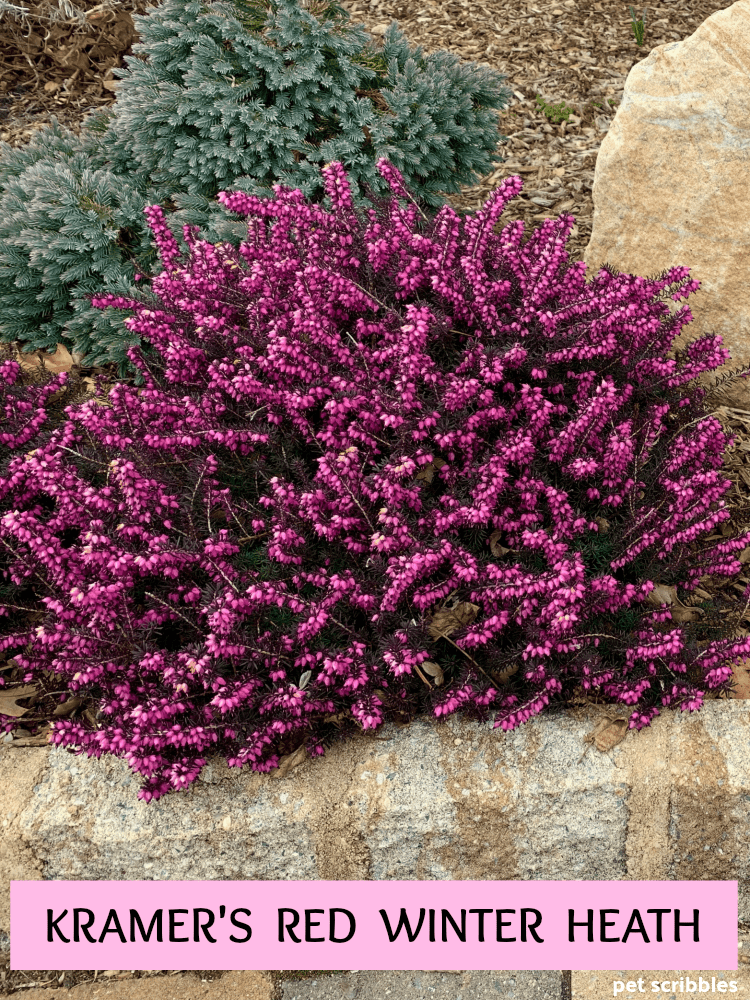
I first learned about heaths and heathers from reading books by the Brontë sisters — especially Wuthering Heights (Emily Brontë) and Jane Eyre (Charlotte Brontë). These classic English novels published in 1847 conjured up mysterious yet magical ideas of what heath and heather looked like on the English moors so vividly described.
Now that I have spent several years growing Kramer’s Red Winter Heath — a hardy and vibrantly colored heath — I marvel at how the Brontës, among other English novelists of the time, described these amazing little shrubs so well.
Video included! Further down in this guide, watch a video I filmed in Springtime, so you can see the shrubs close up and among daffodils!
Table of Contents
- What is Kramer’s Red Winter Heath?
- What is the difference between Heath and Heather?
- Why you want Kramer’s Red Winter Heath in your garden
- Kramer’s Red Winter Heath — Flowers and Foliage
- Growing Requirements
- Planting, Pruning and Deadheading
- What about deer and rabbits?
- Adding Kramer’s Red Winter Heath to our garden beds
- Kramer’s Red throughout Summer, Fall, Winter and Spring
- Where to buy
What is Kramer’s Red Winter Heath?
Kramer’s Red Winter Heath is a mounding evergreen shrub with stunning Winter color: its breathtaking magenta blooms cover the shrub from January through April.
This Winter heath is very hardy and requires little care once established in the garden.
The heath flowers attract bees on mild Winter and early Spring days with the tiny but sturdy bell-shaped blooms.
The Summer and Fall evergreen color means this shrub provides color year-round, which is one of the benchmarks of a fabulous garden shrub.
Kramer’s Red makes a great groundcover and smothers weeds wherever it’s grown.
What’s the difference between Heath and Heather?
Heath and heather plants are members of the Ericaceae family, which includes rhododendrons, azaleas, bog rosemary, cranberries and blueberries to name a few.
The terms heath and heather seem to be freely interchangeable in usage, but there are differences among these plants.
One easy way to identify which is which: Heather has scale-like foliage, while Heath has needle-like foliage.
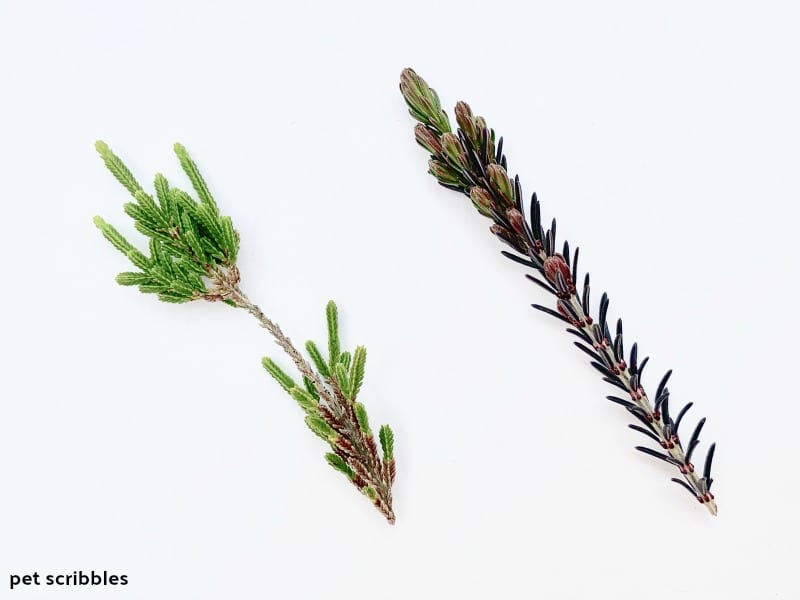
Kramer’s Red Heath is also Kramer’s Red Heather
Often sold at the big box home improvement stores as Kramer’s Red Heather, this evergreen is also known as Kramer’s Rote and the plant classification is Erica x darleyensis Kramers Rote. The word “rote” means red in German.
Other names you may find for this Winter flowering heath include Kramer’s Rote Heath, Kramer’s Red Winter Heather, Kramer’s Red Heather, Red heather plant, Winter flowering heather, and numerous other variations.
The plant tags on the heath shrubs I’ve purchased in the past called them Kramer’s Red Heather, but it’s actually a Winter heath:
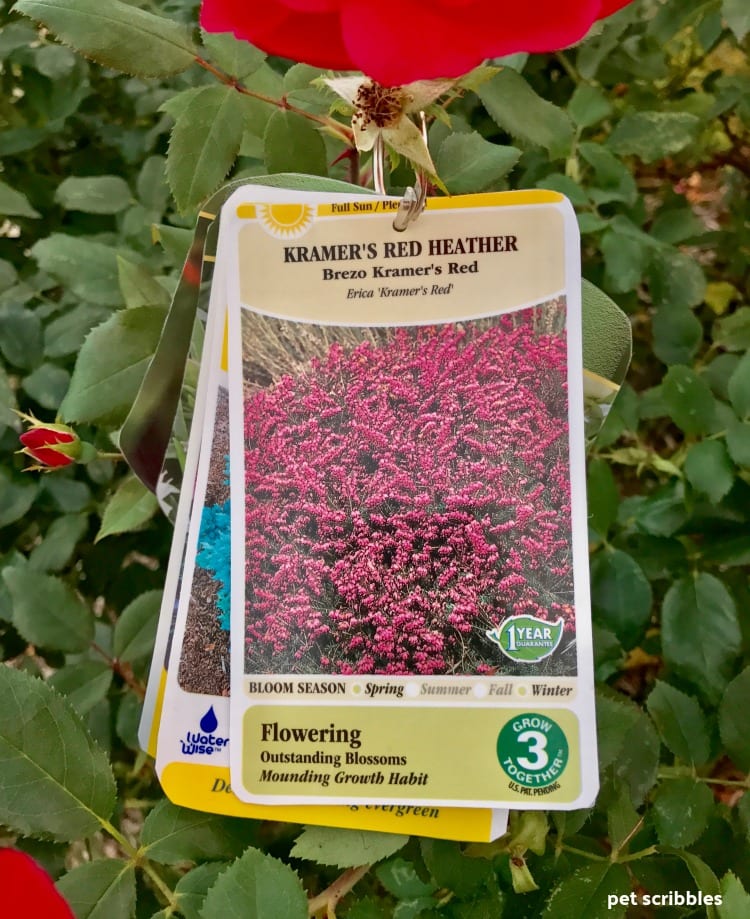
(The image above shows my helpful solution for keeping your plant tags handy so you can refer to them often: The Best Plant Tag Solution.)
I end up using both heath and heather terms myself at times, and might even within this article by accident, so I hope this helps to explain — in a simple way — heath and heather plants.
Why You Want Kramer’s Red Winter Heath In Your Garden
This little evergreen shrub works year-round in the garden. Kramer’s Red is an easy-care, unfussy shrub that will give you a long season of splendid color from Winter through early Spring.
In the Summer, Kramer’s Red heath handles heat and humidity easily while producing reliable green color. In the Winter and early Spring, this shrub blooms its heart out with gorgeous, vibrant blooms — no matter what the weather is doing.
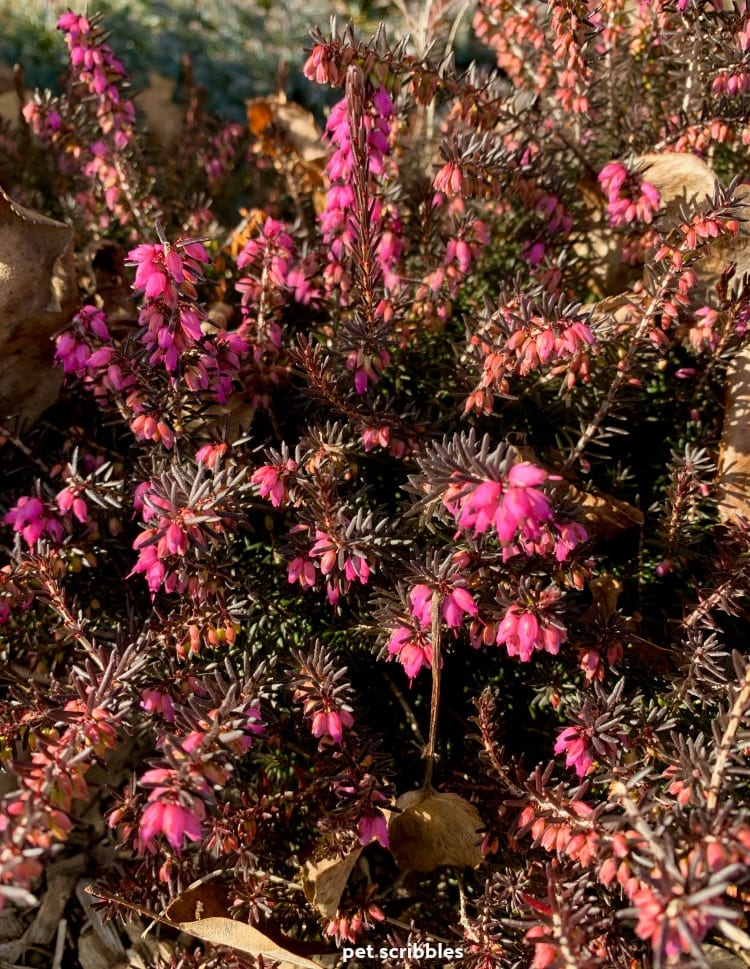
Once I added Kramer’s Red Winter Heath shrubs to one of our garden beds and saw how great they performed, I added more of them to other spots. And when all of those plants bloomed their hearts out all Winter and Spring, I purchased even more of them this year.
Kramer’s Red Winter Heath Flowers and Foliage
Flowers
The flowers are tiny and bell-shaped, completely covering the shrub during their long season of bloom.
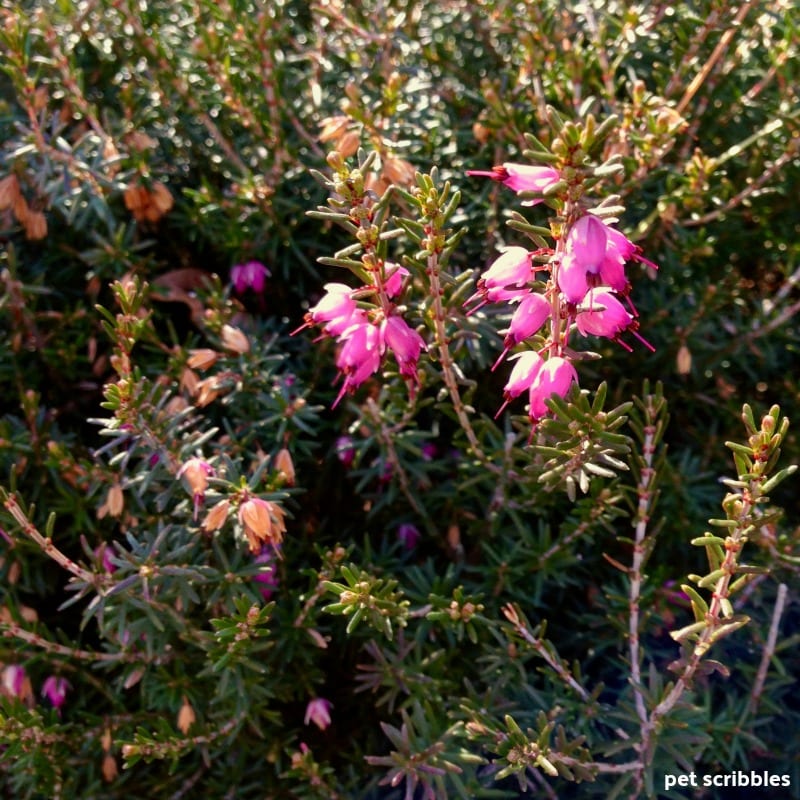
Color
Magenta flowers, yet it is called a red heath or red heather plant. The flower color can look like fuchsia, and sometimes a deeper magenta-red color. Overall, I think magenta is the best way to describe the color.
Bloom time
Early Winter through Mid Spring.
The flowers usually finish blooming by the end of April or beginning of May.
At the end of Kramer’s Red Winter Heath’s long blooming season, its flowers begin to fade so the shrub — up close — looks to have both pink and magenta flowers all over the shrub:
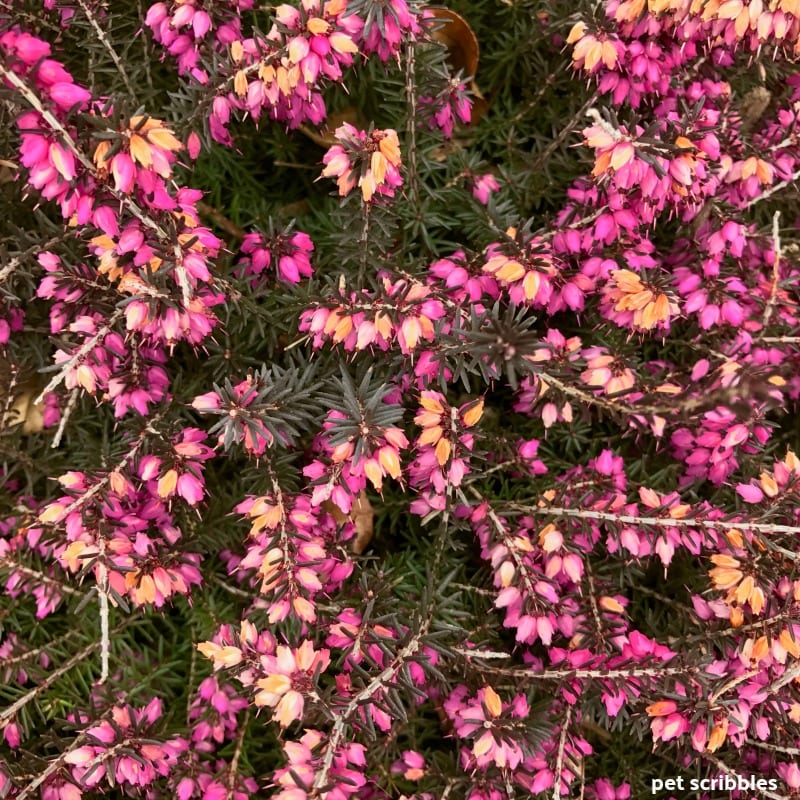
All of the faded blooms will eventually fall off or blow away, as if the plant is self-cleaning!
Here’s the heath with some dried blooms still hanging on among the new green growth in late May:
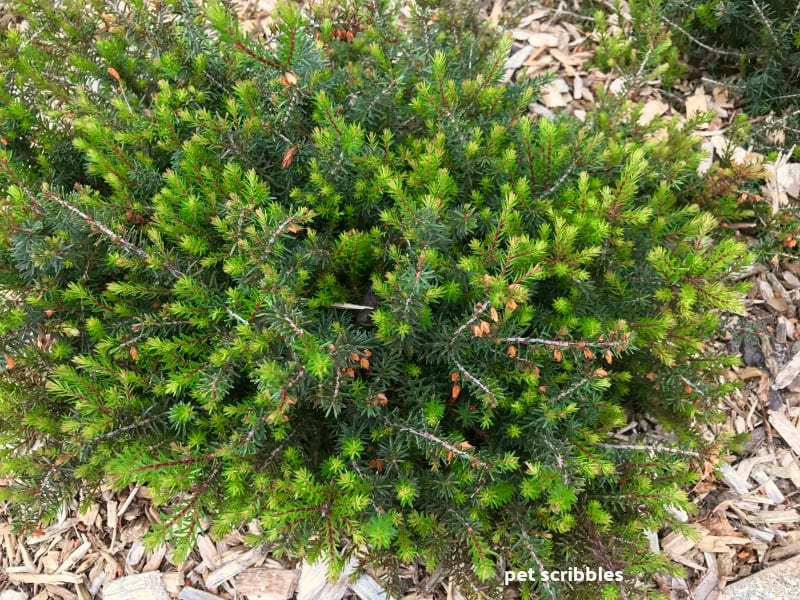
New growth on Kramer’s Red is bright green, which is followed by the flower buds (also bright green) that form during the Summer.
This image shows what the flower buds look like at the end of August:
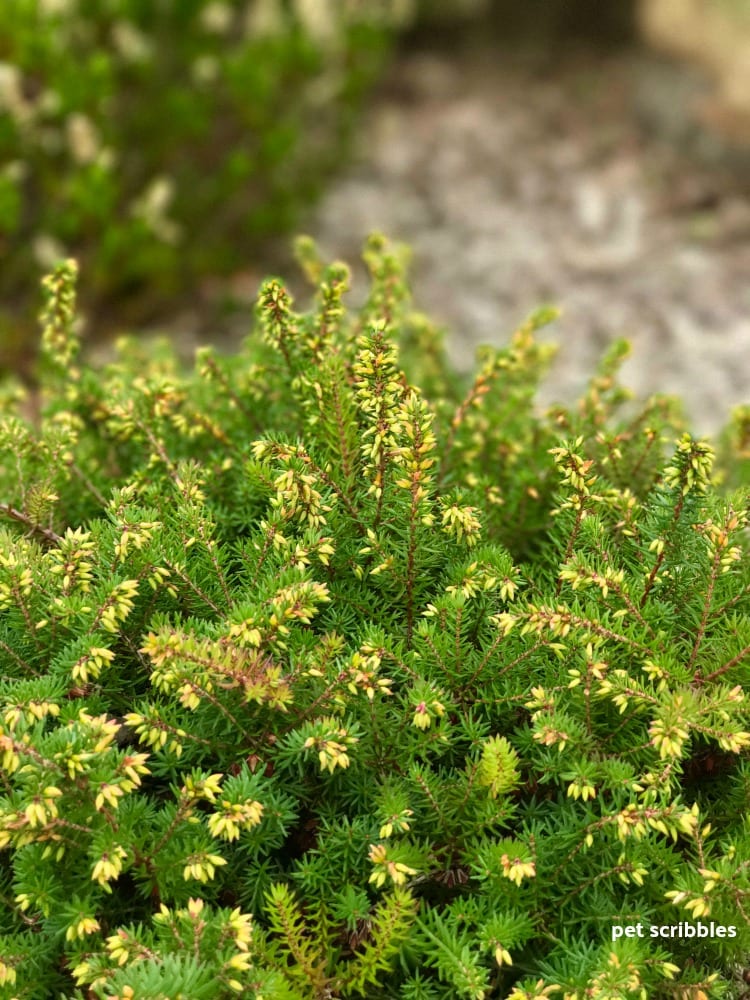
Foliage
Heath has needle-like green (evergreen) foliage, which can turn to bronze in the Winter and early Spring season, when it’s hidden behind the profuse blooms.
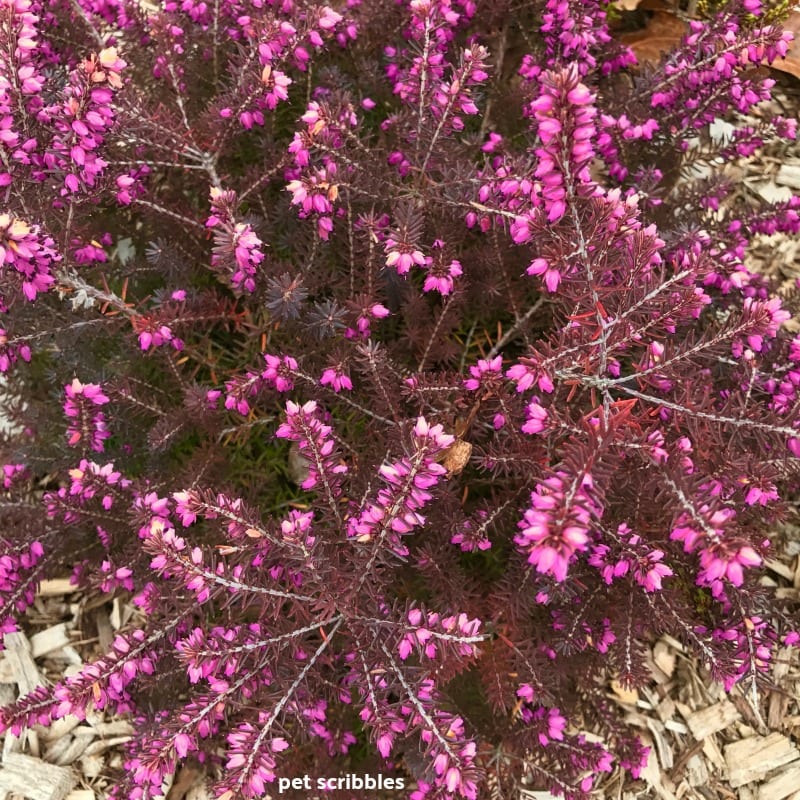
Sometimes late Winter foliage looks almost black to me, but again it just shows off the striking magenta flowers even better. In Summer, the foliage color is a deep green, with brighter green new growth at the tips.
Growing Requirements
Hardiness
Zones 6 – 8; with some gardeners growing Kramer’s Red Heath in Zone 5.
If you’re unsure, check with your local garden center for hardiness in your particular zone.
I’m in Zone 7, in southern New Jersey near the coast.
Size
Spreads slowly up to 18” high by 24” or more wide.
Light
Best in full sun. Any bit of shade and this particular heather will not flower as well.
Soil
Neutral to acid soil, and well draining.
Water
Keep well watered until established. Drought tolerant once established.
However, do watch out during the high heat of Summer that they don’t completely dry out. We keep ours well watered due to the high heat, humidity and blazing sun, especially in July and August.
Fertilizer
Kramer’s Red is an acid-loving plant, so I use Holly Tone by Espoma every Spring. It’s a slow-release organic fertilizer perfect for heaths and heathers.
How to plant Kramer’s Red Winter Heath
No part of the heath root ball should appear above ground. Once planted, the bottom of the foliage should be resting on the ground.
Plant Red Kramer’s Winter Heath in groups for the best visual effect.
I usually plant a minimum of three together. (And yes, I started out with just one or two here or there. I’ve smartened up since then!)
We added these three Kramer’s Red heaths in a triangle shape behind one of our landscape lamps:
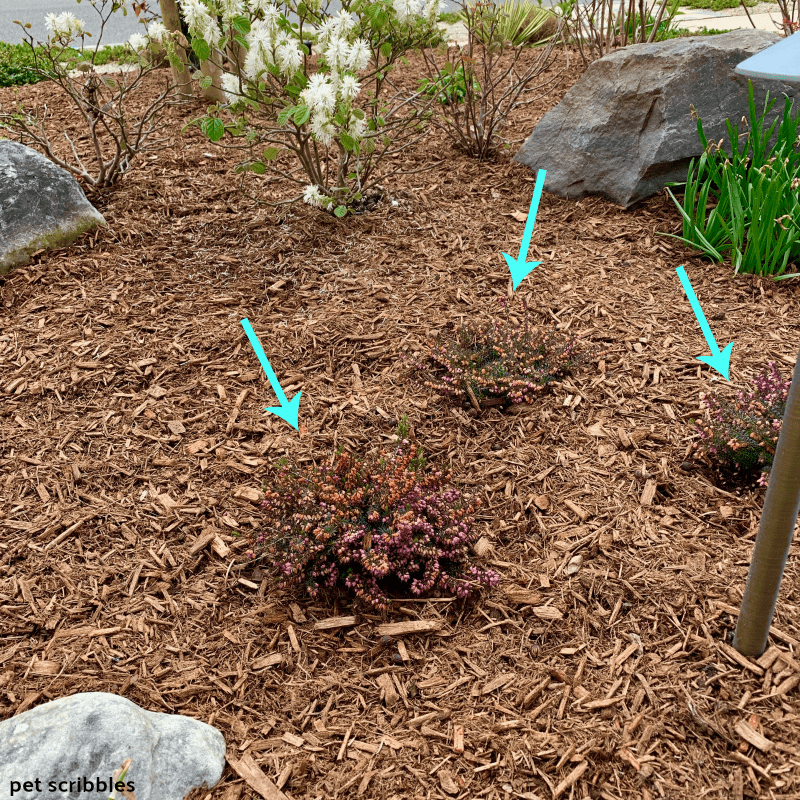
(The white bottlebrush flowers you see in the image above are part of the Fothergilla shrub – another one of my favorite easy-care plants with year-round garden interest.)
Pruning and Deadheading
Pruning
Some people give these shrubs a light shearing once a year. Otherwise you only need to remove any dead stems.
If you want to prune yours, do so in the Spring before the end of April, while the blooms are fading.
You don’t want to prune any later than April, as next year’s flower buds are formed during the Summer months.
In my own experience, this particular heather does not need to be pruned, as it isn’t an aggressive spreader. As long as my Kramer’s Red are compact and bushy, I won’t shear them. However, if they begin to get leggy, I’ll definitely consider it.
Deadheading
No need as the flowers bloom non-stop from Winter to Spring. At the end of their blooming season, the tiny dried flowers fall off or blow away in the wind.
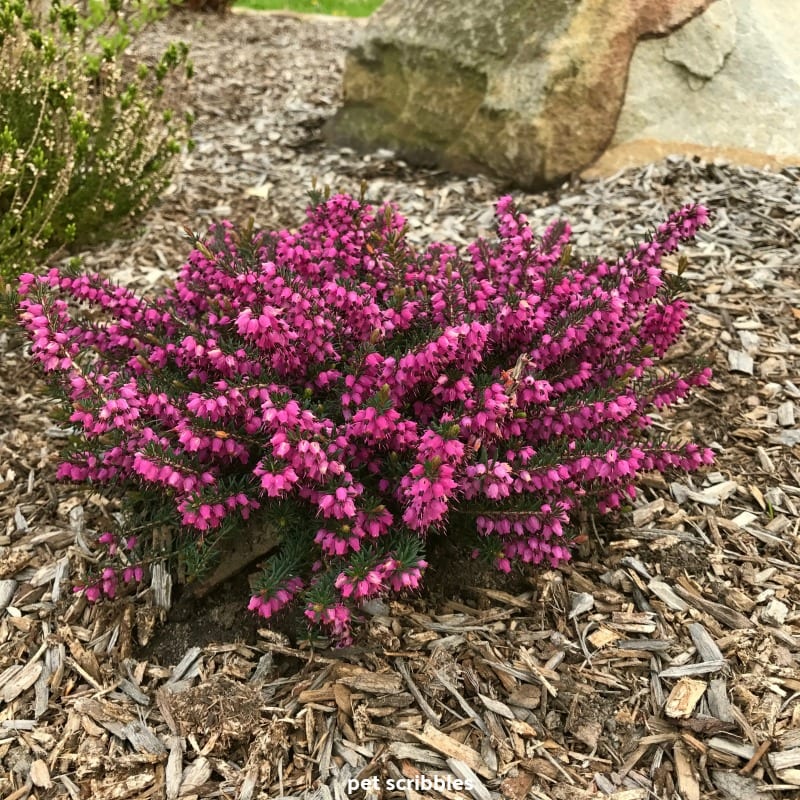
What about deer and rabbits?
Deer resistant?
Yes, except I can’t promise anything if the deer decide to trample on them with their hooves.
Rabbit resistant?
Unclear, and I have yet to read anything definitive one way or the other about heaths and heathers.
I’ve watched the rabbits that love our gardens skip over our Kramer’s Red. (Wasn’t so lucky with our Cheyenne Spirit Coneflowers, however…)
Kramer’s Red Winter Heath in our backyard garden
When we first moved into our home, and made a backyard garden for the first time, we planted two small Kramer’s Red Winter Heaths.
Because Kramer’s Red Winter Heath is sold here in the US in the Spring, while it’s still blooming, I initially assumed it was a Spring bloomer.
Imagine our surprise when, the following Winter, we looked outside and noticed the bright magenta blooms from across the backyard! And this was in January!
I still thought it was just blooming early, perhaps due to a mild Winter we were having at the time.
This coincided nicely with my new obsession with gardening books — one that continues to the present day — and I quickly learned this particular heather is actually a Winter heath and blooms profusely beginning in early Winter.
The next year I planted Little Leo’s Leopard’s Bane next to the Kramer’s Red heath:
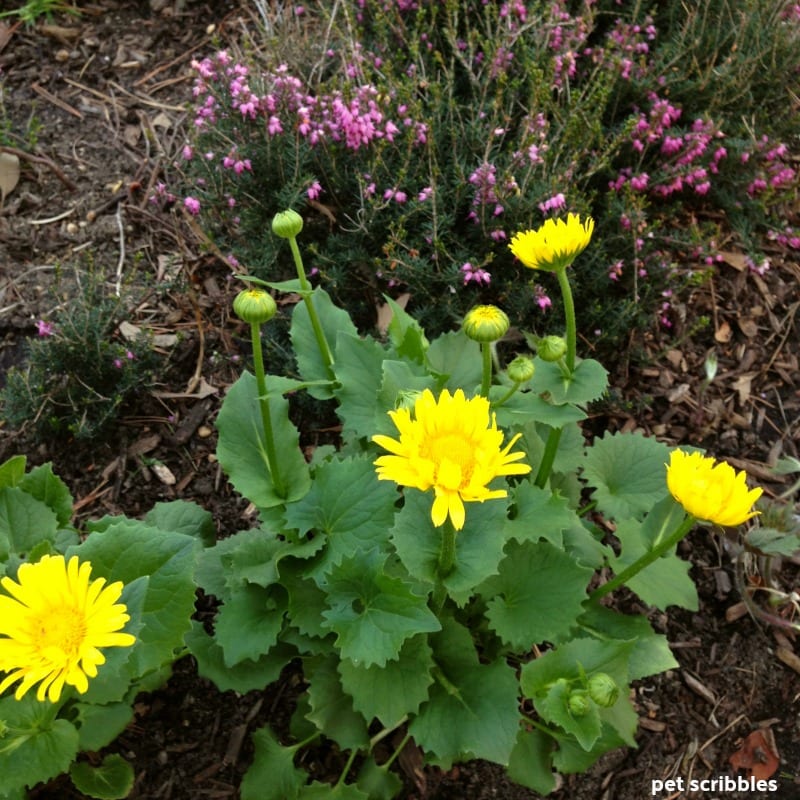
Leopard’s Bane is a reliable Spring bloomer with such pretty yellow flowers — I honestly don’t know why it isn’t more popular with gardeners.
Those bright yellow flowers coupled with the magenta blooms of Kramer’s Red is always a much-needed pick-me-up in the Spring garden. With both of these perennials being completely care-free, it’s an easy way to enjoy Spring color every year.
The image below shows our Kramer’s Red shrubs in that same backyard garden bed at the end of May.
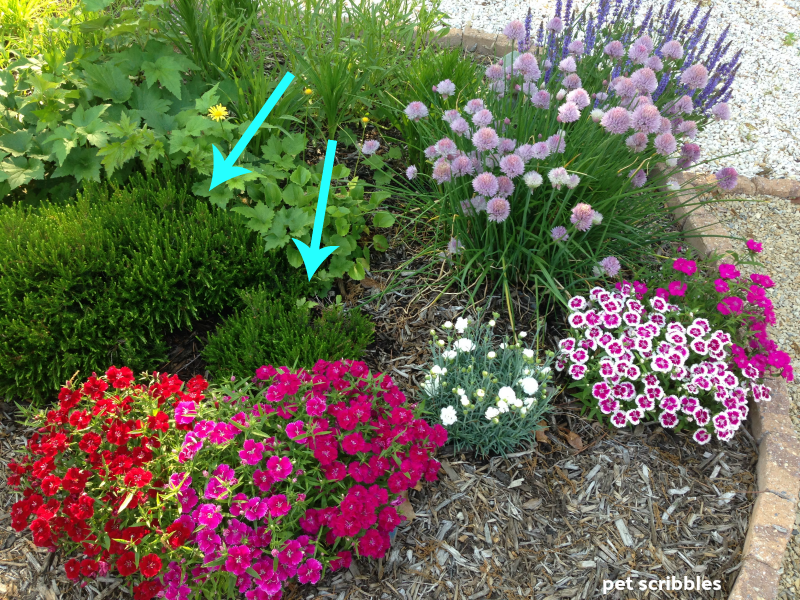
Once it’s finally finished with its long blooming season, this evergreen shrub quickly becomes a wonderful background color to show off other garden flowers such as the dianthus, alliums, and salvia seen here.
Kramer’s Red Winter Heath in our front garden beds
Fast forward a couple of years and I wanted to add more evergreen color to one of our front garden beds.
Here’s what the bed looked like in a typical Summer up to that point:
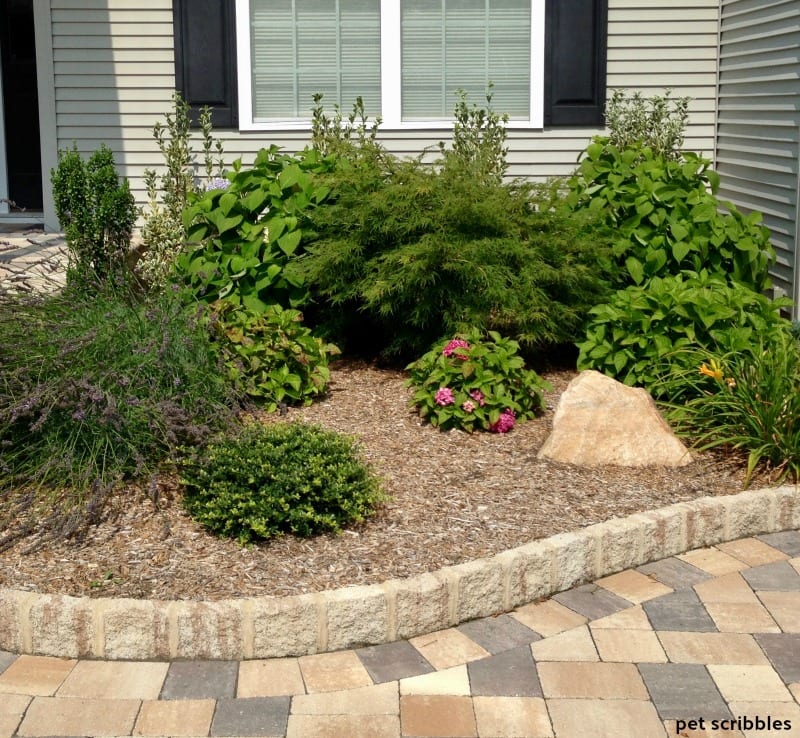
There is a nice variety of plants in this image, but many of them turned to sticks in the Winter season.
Off we went to one of the home improvement stores, and I stocked up on my favorites: Candytuft, Lithodora, and Kramer’s Red Winter Heath!
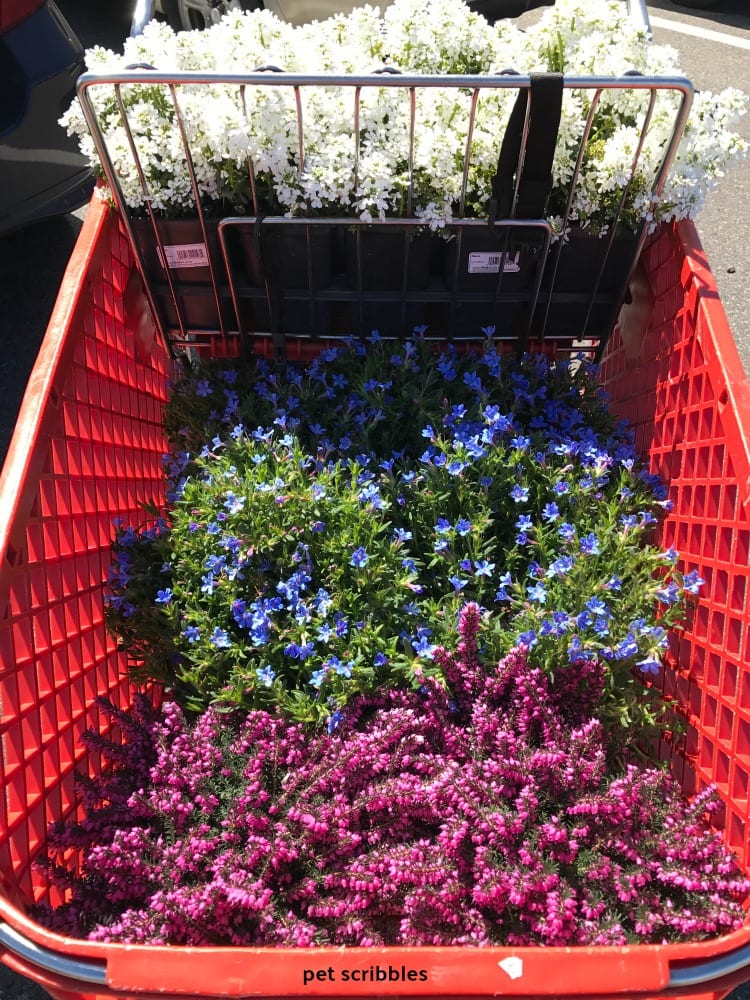
We planted two Kramer’s Red in our lamppost garden, then planted two on either side of a white heather in a different front garden bed.
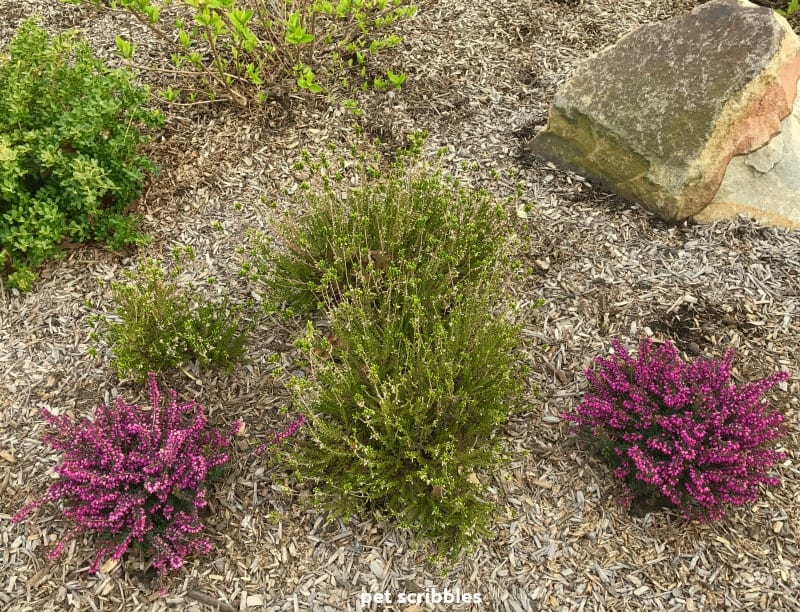
This particular white heather has sporadic blooms in Spring through the late Summer for us, but it isn’t a profuse bloomer — I don’t even know what it is, actually. I truly think this heather doesn’t know when to bloom, so it just spits out a few blooms here and there.
Here they are in the beginning of September:
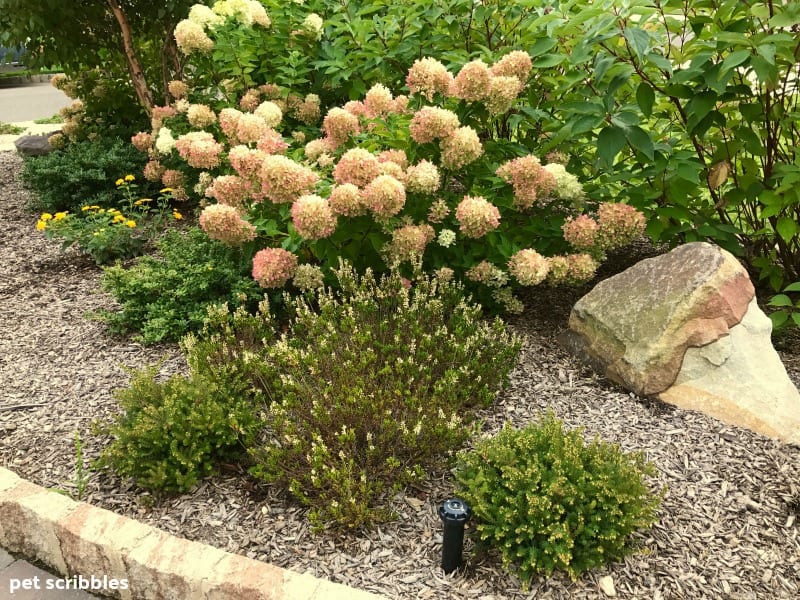
We also added two Kramer’s Red into the front bed I mentioned earlier:
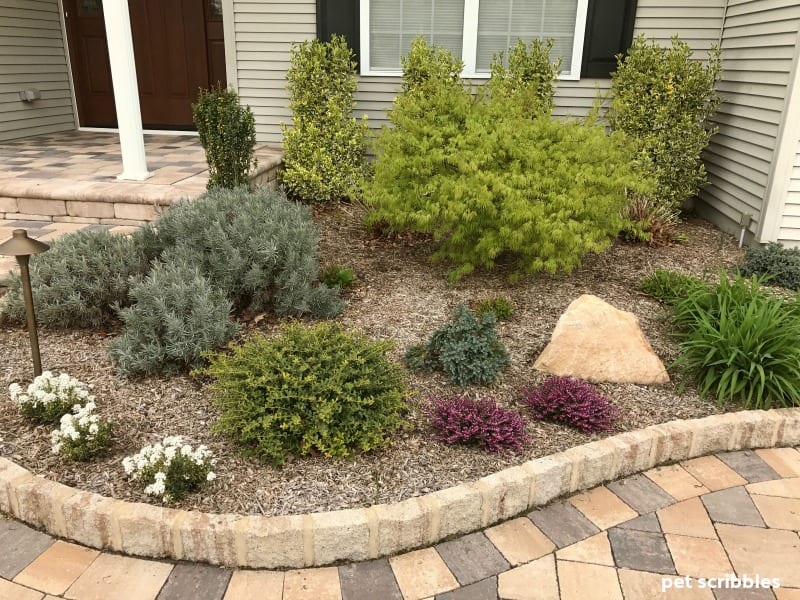
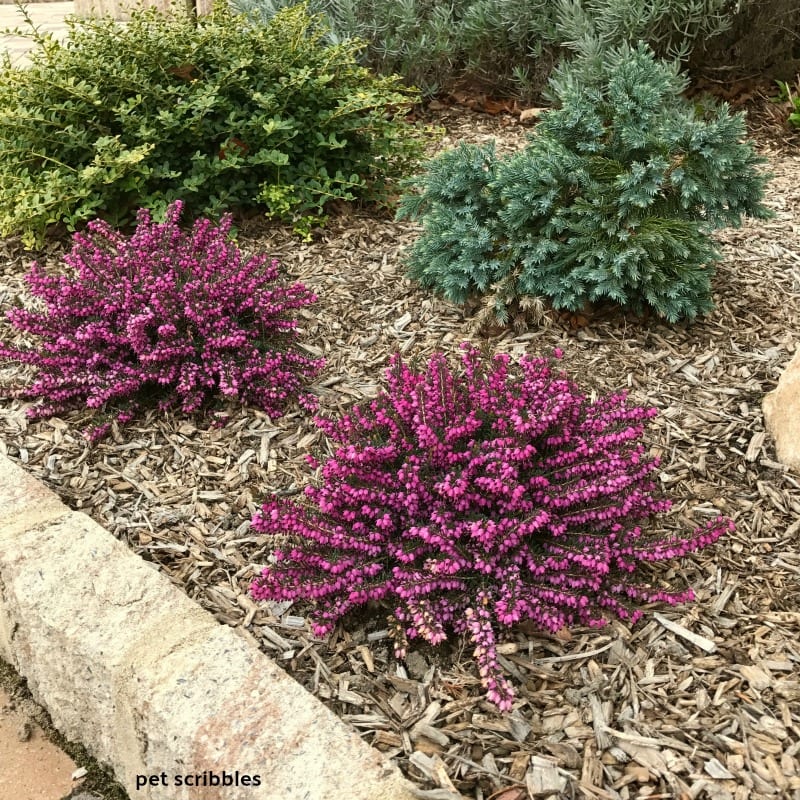
Evolution of a garden bed!
During this time we also moved those oversized hydrangeas from the front gardens to the backyard. We love those hydrangeas, but they were crowding the other plants and vice versa.
This bed still looks nice and lush and full without the hydrangeas, but my goal this year is to add more Summer flower color back into this bed.
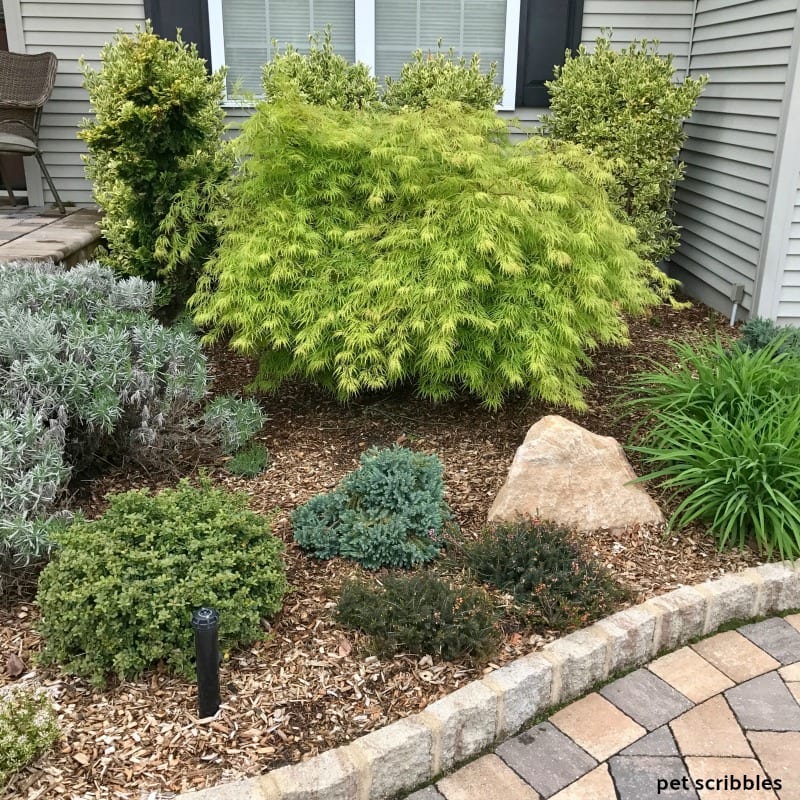
You can read and see more about moving our hydrangeas in my Pia Hydrangea article.
To see how this bed has changed over time, see this article: Evolution of a Garden Bed — Front Entrance.
Kramer’s Red Winter Heath in Summer and Fall
Once the blooms are gone, Kramer’s Red Winter Heath easily takes its place as a reliable Summer evergreen in the garden.
Here’s the lamppost garden in Summer:
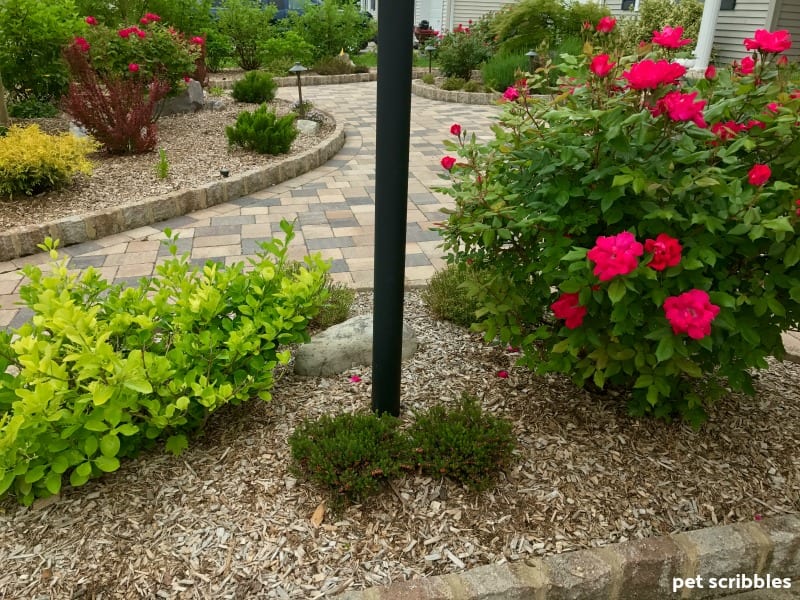
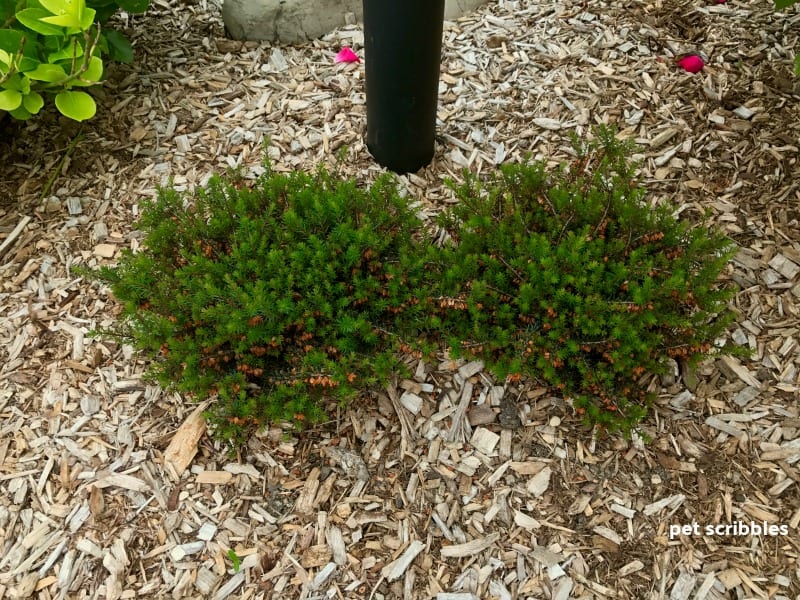
Here’s the front entrance garden bed again in Summer, where the lavender is now blooming its heart out, after being a background evergreen (or ever-gray) shrub during the Winter. (This form of lavender — called Lavender Phenomenal — is the best lavender for heat and humidity.)
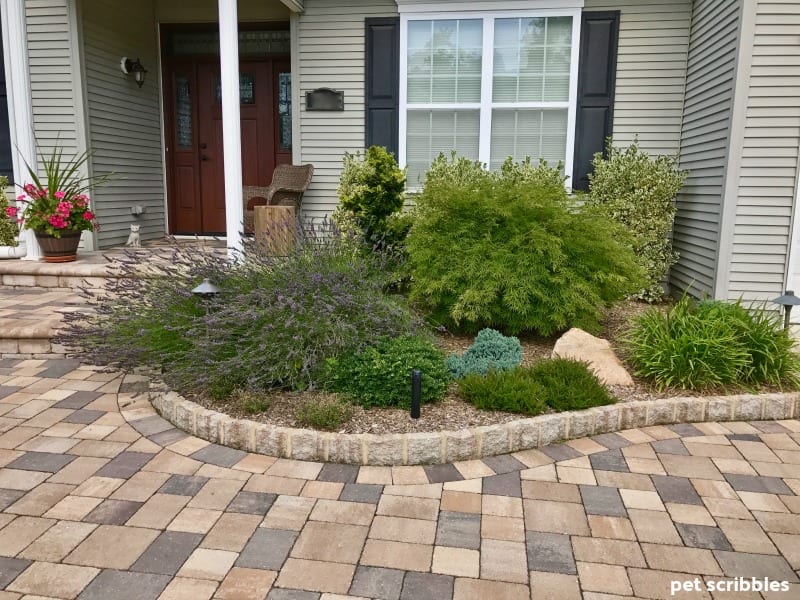
During the Fall, the evergreen color provides a nice backdrop to Fall colors, including leaves I may or may not readily clean up.
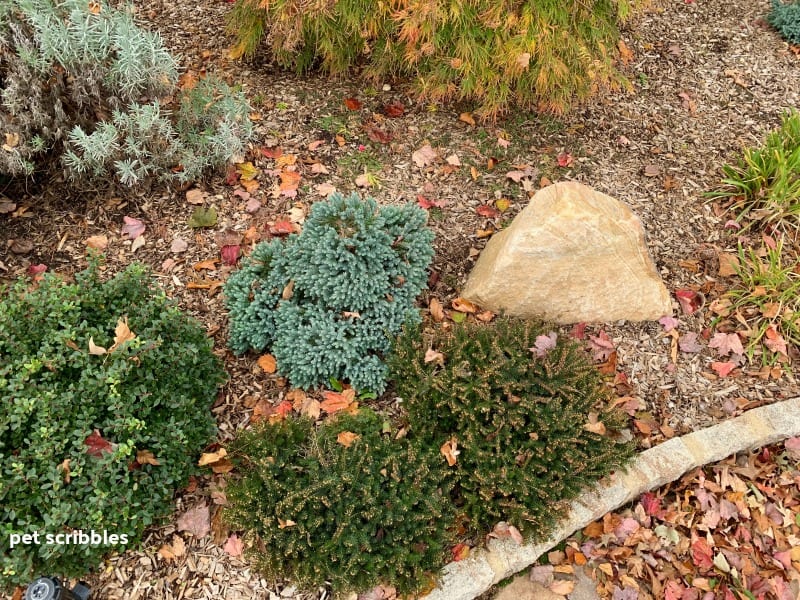
Kramer’s Red Winter Heath in Winter
Kramer’s Red Winter Heath looks brilliant with the vivid flowers surrounded by snow — although the only images I have taken so far show the Winter heath actually covered in snow!
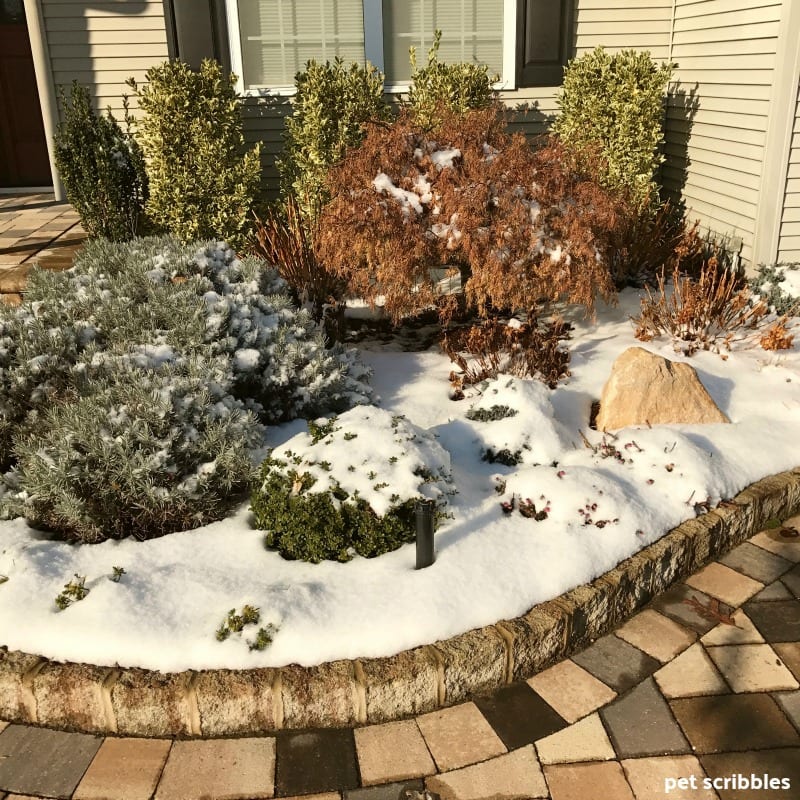
However, the snow does nothing to the gorgeous Winter blooms, and when you’re up close, you can still enjoy the magnificent color.
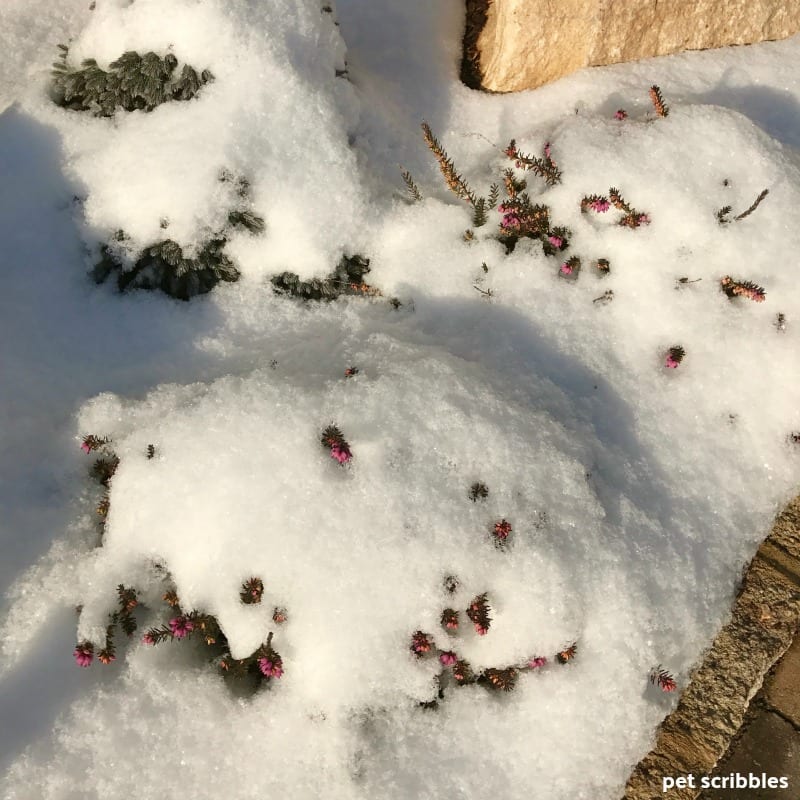
Snow doesn’t smash the plant or damage the blooms — it’s quite a tough little shrub!
Kramer’s Red Winter Heath in December
Around Christmas time, we start to notice a handful of magenta flowers just beginning to show on the shrubs.
Kramer’s Red Winter Heath in January
In January, the tips are blooming and the shrub is covered in the buds about to bloom any day now:
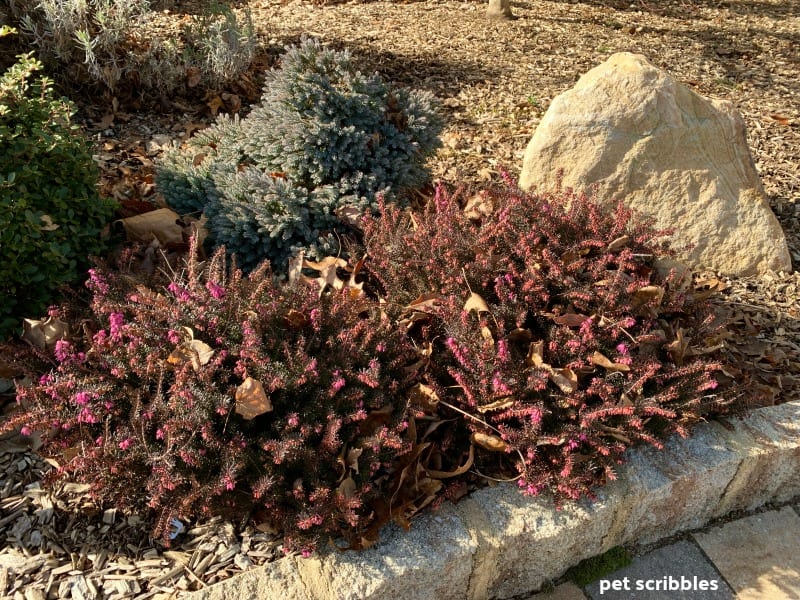
Kramer’s Red Winter Heath in February
By February, this red Winter heath has a mesmerizing glow to it, as it lights up the garden. This is such a welcome scene in the middle of Winter, and really lifts the spirits. I promise you will be in love with this shrub and find excuses to go outside to enjoy its beauty.
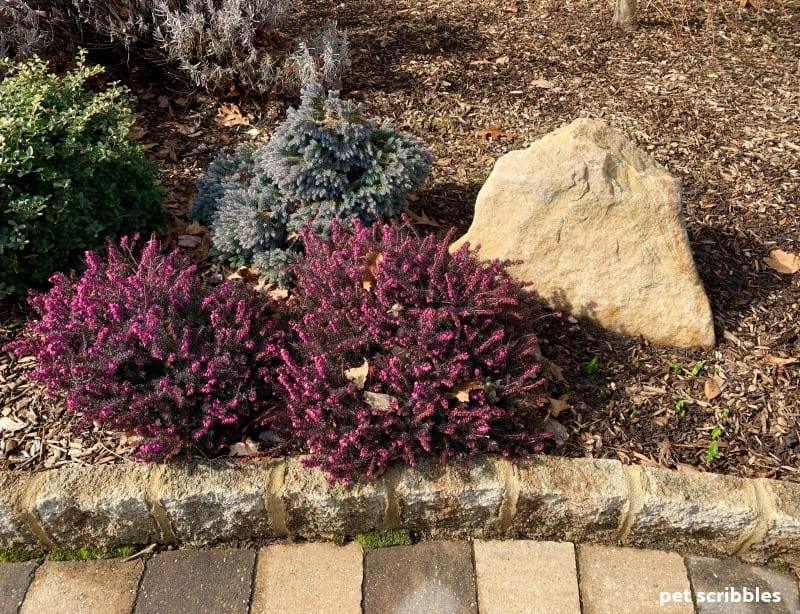
I planted Tete-a-Tete Daffodils all over our front garden beds last Fall, and in February, was excited to see them popping up everywhere, including next to the blooming Winter heath.
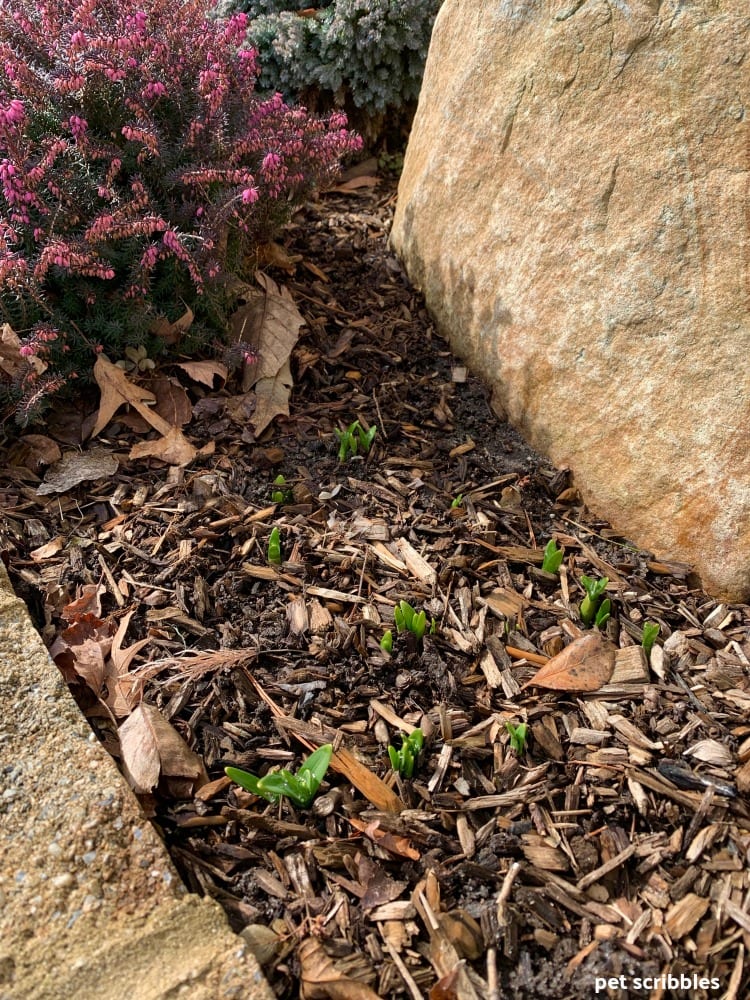
Kramer’s Red Winter Heath in Early Spring
By mid-March, the blooming heath was even more dazzling than I remembered from previous years. Not that the shrub improved over the years, but just that it takes my breath away every single year!
Every. Single. Year.
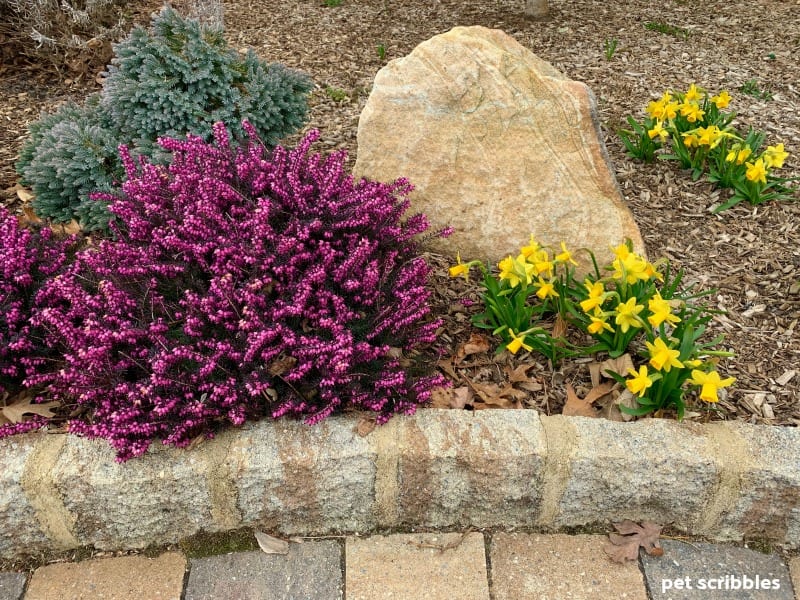
I must have pointed out this pretty combination of magenta and yellow to my husband about a zillion times. That’s how happy this little vignette made me feel!
Time to buy more heath!
In April, I did what any other self-respecting, heath-obsessed gardener would do: I purchased even more of these easy-to-grow, low-maintenance shrubs!
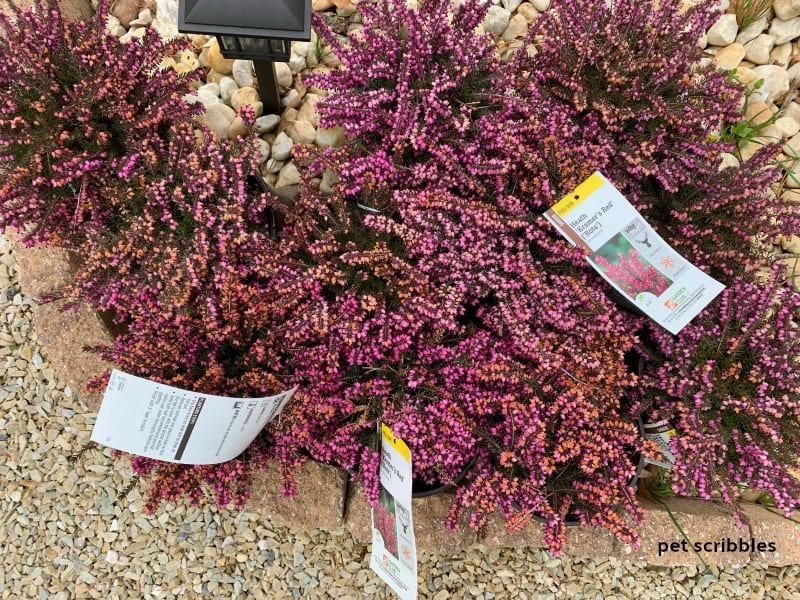
We just added them to our front garden beds, for even more amazing Winter color next year.
We planted three Kramer’s Red Winter Heath shrubs underneath one of our River Birch trees:
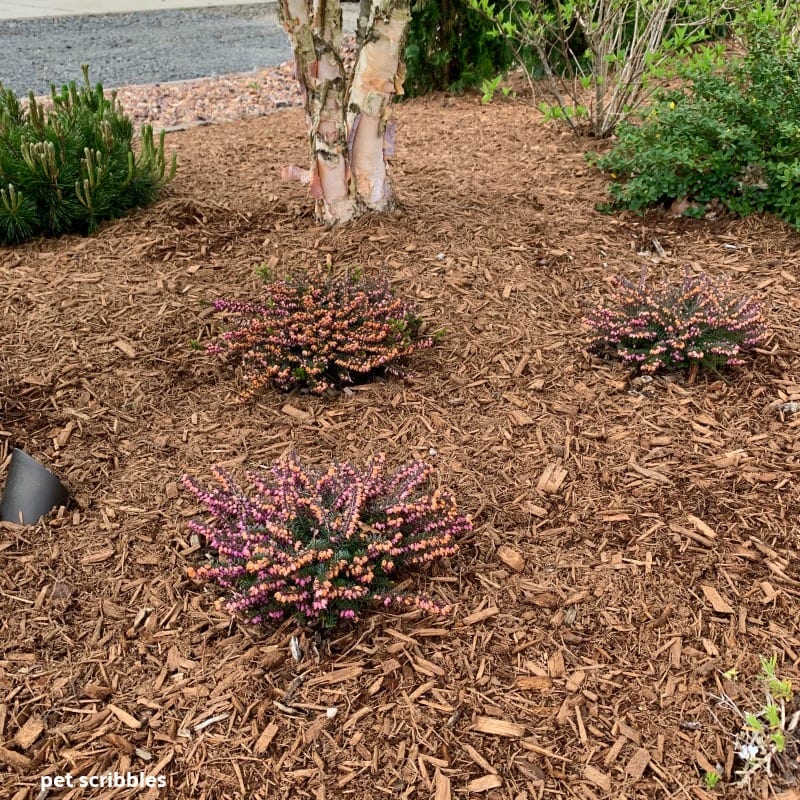
And we added them here and there around the other garden beds, including adding one more to our lamppost bed:
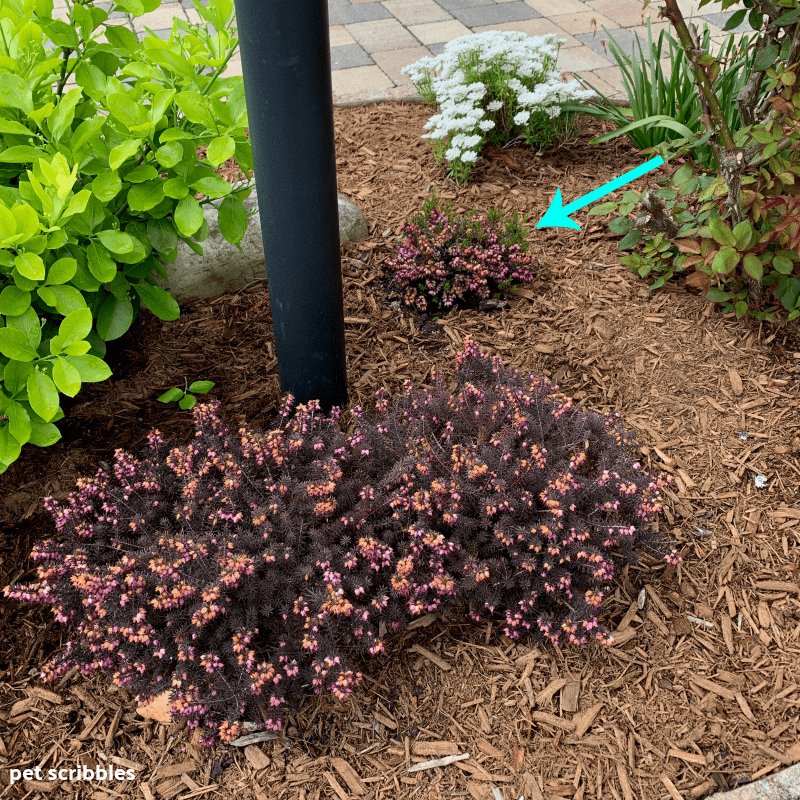
Yes, I’m obsessed.
But when I find a shrub that works year-round — surviving the heat and humidity flawlessly in the Summer while providing reliable green color, plus blooming its heart out during the long Winter season, thriving without any effort on my part — I consider that a successful shrub that needs to live my garden beds.
Where to buy Kramer’s Red Winter Heath
You should be able to find this Winter heath at your local garden nurseries or the big-box home improvement stores.
In the past, I’ve purchased them at Lowe’s (sold as Kramer’s Red Heather). This year I purchased them at Home Depot (sold as Heath Kramer’s Red ‘Rote’ on the plant tag).
Always ask your local garden nursery if they can special order a particular plant or shrub for you if they don’t currently have it in stock.

Spring Garden Video: Kramer’s Red Winter Heath
Enjoy this video where I take you on a tour, showing you the outstanding Spring color this fabulous heath provides! Bonus to see lots of daffodils too!
I hope you’ll try this fabulous, easy-care, flowering evergreen shrub. There’s nothing like it for amazing Winter color when things can look a bit dreary!
Happy gardening!

I was excited to read your post about Red Heath as I picked up one this year myself. The colour just spoke to me, and I will be waiting for January to see it bloom again. I will be getting some more plants this coming spring as well.
Yes Deb — it’s that amazing color, isn’t it? I felt the same thing when I first saw it too! Can’t wait for you to see yours blooming in the Winter, and yes — it will make you want to buy more of them come Springtime! I’m smiling as I type this, because I went through — and am still going through — the same thing — almost like I can’t have enough of this little shrub! Please stop back or drop me an email and let me know how yours blooms!
Wow! I want some of these please!
Oh Barbara — there’s nothing like it to light up the Winter garden!
Thank you sooooooo much for this! The year round photos are more helpful than any other info I found on the internet for winter heath.. I’m buying three online! My perennial garden pretty much disappears in winter.. I’m adding plants with year-round foliage and a winter blooming shrub is a bonus!
Thanks Elizabeth! Yes, that’s one of the reasons I love sharing year-round photos because if you just see one “pretty” picture of a plant or shrub, there’s really no idea what it will look like at other times of the year. Glad this helped you! And glad you’re adding some Winter interest in your garden. You’ll love it! (Keep me posted too!)
Thank you so much. Very informative. This is what I have been looking for. I love that you show the photos of them in every season. I also have 4 of them in my garden. I am looking forward to get more next spring. I did trim them to be like globe shape and they are beautiful. BTW, I love your YouTube and I subscribe.
Thanks so much Joy! I love showing photos of every season because that’s what I wish I would see more of when I’m interested in plants and shrubs. Yes, after I planted our first two, I ended up stocking up on these the following Spring! I wish all the different heath and heather varieties that exist were widely available in the US. I’d end up trying so many more. So glad you subscribed to my YouTube channel — I’ve only begun doing garden videos but am enjoying it and glad you are too!
Laura
Great article!
I’m a SC transplant after 74 years in Atlantic County, so I know exactly what your growing conditions are in Little Egg.
Would love to add some of these in my gardens down here in the Upstate (Greenville County). Do you think they would do well
in our red clay & rather intense summer heat?
Thanks Steve! As you can probably tell, I adore this little shrub! The ones that are planted in full Sun do well, but some of them seem a bit tired and the color almost blanched a bit when we get those awful Little Egg hot and humid days. I don’t think the clay bothers them as much as the intense sun. I have three planted underneath a River Birch tree where they get some shade and they seem happier than the three I have in our center bed in full Sun. I also think it takes them a few years to get established where they can better handle the hot spells. I’m not familiar with red clay, so not sure if it is similar to the lovely (not) clay soil we have here. If you were to plant them, give them shade during the hottest part of sunny days, which is usually the afternoons. (However, the best blooming comes from full sun.) And make sure they get enough water during their first two years while they get established. The best way to know if these are happy is how they look in the Winter when in bloom. If blooms are average, they might need more care. If the blooms are vibrant, they are happy.
omg! best blog i have found ever. I was looking for informtion on Red kramer and came across this blog. Amazing info! thank you for the detailed explanation. I got some last spring and was surprised to see it blooming starting last month. after reading your blog i know that this is their blooming season. planning to get more this spring im filling up an edge next to my lawn.
Oh Priya — I’m SO happy for you! I remember when this happened to me. I looked outside one Winter day and saw what I swore looked like flowers but it couldn’t be in the Winter?!? I went outside and was so surprised and thrilled! I did the same thing: bought more! LOL Thanks so much for letting me know! And enjoy the Winter into Spring gorgeous color!